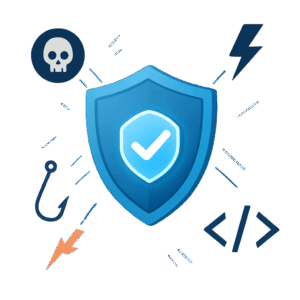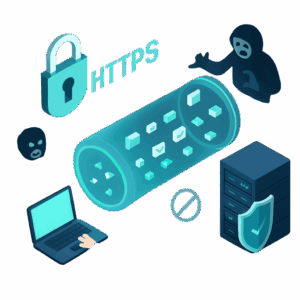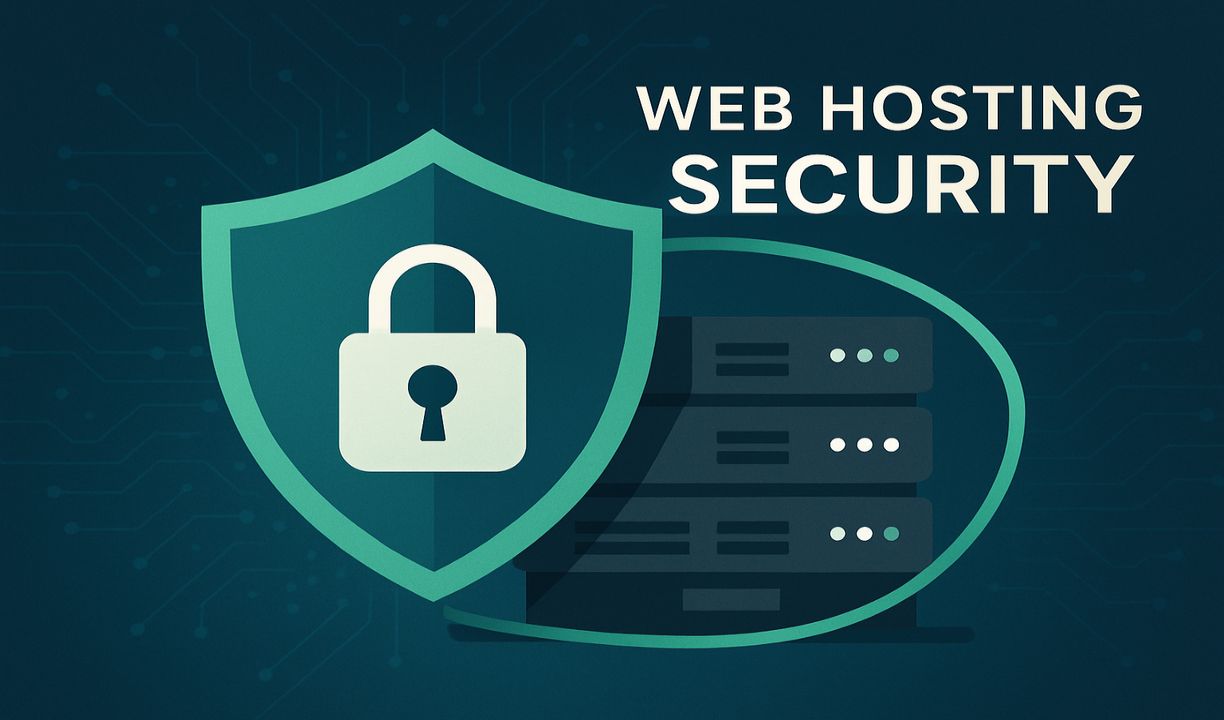Cyber threats are a constant and evolving danger in an increasingly interconnected digital world. For any business or individual with an online presence, your website is a primary target for malicious actors. A compromised website can lead to data breaches, financial losses, reputational damage, and a significant loss of customer trust. While many focus on website design and content, the underlying security of your web hosting environment is equally, if not more, critical.
This comprehensive guide will delve into the multifaceted world of web hosting security, exploring your website’s common cyber threats and outlining essential strategies and best practices to protect your online assets. We will cover both server-side security measures implemented by your hosting provider and client-side actions you can take to fortify your website. Understanding and implementing these security layers is paramount to safeguarding your data, maintaining user trust, and ensuring the continuous operation of your online business. By the end, you’ll understand why choosing a security-conscious hosting provider like Mukhost.com is your first line of defense against cyber threats.

The Evolving Landscape of Cyber Threats
In the digital age, the internet has become an indispensable platform for businesses, communication, and commerce. However, with this increased reliance comes an escalating threat landscape. Cybercriminals are constantly evolving their tactics, making it imperative for website owners to understand the various threats they face. A lack of awareness can leave your website vulnerable, leading to devastating consequences. This section will detail some of the most prevalent cyber threats targeting websites and web hosting environments.
Malware and Viruses
Malware, a portmanteau for malicious software, is a broad term encompassing viruses, worms, Trojans, ransomware, spyware, and adware. These insidious programs are designed to infiltrate computer systems and networks, often without the user’s knowledge, to disrupt operations, steal data, or gain unauthorized access. For websites, malware can manifest in various ways:
- Website Defacement: Malicious code can alter the appearance of your website, replacing legitimate content with offensive or propaganda messages.
- Data Theft: Malware can be used to steal sensitive information, such as customer data, login credentials, and financial details, leading to severe privacy breaches and regulatory penalties.
- Spam Injection: Compromised websites can be used to send out spam emails, damaging your domain’s reputation and potentially getting your IP address blacklisted.
- SEO Spam: Malicious code can inject hidden links or content into your website, redirecting visitors to other sites or manipulating search engine rankings, which can lead to your site being penalized or delisted by search engines.
- Ransomware: While more commonly associated with individual systems, ransomware can also target web servers, encrypting website files and demanding a ransom for their release. This can bring your entire online operation to a halt.
Malware often spreads through vulnerabilities in website software (like outdated CMS platforms or plugins), weak passwords, or malicious file uploads. Regular scanning and robust security measures are essential to detect and remove these threats.
DDoS Attacks
A Distributed Denial of Service (DDoS) attack is a malicious attempt to disrupt the normal traffic of a targeted server, service, or network by overwhelming the target or its surrounding infrastructure with a flood of Internet traffic. The goal is to exhaust the target’s resources, making it unavailable to legitimate users. DDoS attacks are often launched from multiple compromised computer systems, which form a ‘botnet.’
There are various types of DDoS attacks, but they generally fall into three categories:
- Volume-based attacks: These attacks aim to saturate the bandwidth of the target, such as UDP floods, ICMP floods, and other spoofed-packet floods.
- Protocol attacks: These attacks consume server resources or the resources of intermediate communication equipment, such as SYN floods, fragmented packet attacks, and Ping of Death.
- Application-layer attacks: These attacks target specific web applications and are often the most sophisticated, such as HTTP floods, DNS query floods, and slow-read attacks.
Even a short DDoS attack can cause significant financial losses, reputational damage, and disruption to services. Effective DDoS protection is crucial for maintaining website availability, especially for e-commerce sites and online service providers.
SQL Injection
SQL Injection (SQLi) is a code injection technique used to attack data-driven applications, in which malicious SQL statements are inserted into an entry field for execution (e.g., to dump the database contents to the attacker). This vulnerability occurs when an application constructs SQL statements using user-supplied input without proper validation or sanitization.
Attackers can use SQL injection to:
- Bypass Authentication: Gain unauthorized access to user accounts or administrative panels.
- Extract Sensitive Data: Retrieve confidential information from the database, such as customer details, credit card numbers, or proprietary business data.
- Modify Data: Alter or delete data within the database, leading to data corruption or service disruption.
- Execute Remote Commands: In some cases, attackers can use SQL injection to execute arbitrary commands on the server, leading to full system compromise.
SQL injection attacks are particularly dangerous because they can directly compromise the integrity and confidentiality of your website’s database, which often holds the most valuable information.
Cross-Site Scripting (XSS)
Cross-Site Scripting (XSS) attacks are a type of injection, in which malicious scripts are injected into otherwise benign and trusted websites. XSS attacks occur when an attacker uses a web application to send malicious code, generally in the form of a browser-side script, to a different end user. The end user’s browser has no way to know that the script should not be trusted, and will execute the malicious script.
There are three primary types of XSS attacks:
- Stored XSS: The malicious script is permanently stored on the target server (e.g., in a database, in a comment section), and then delivered to users who visit the affected page.
- Reflected XSS: The malicious script is reflected off of a web server to the user’s browser, typically in an error message, search result, or any other response that includes some or all of the input sent by the user.
- DOM-based XSS: The vulnerability exists in the client-side code rather than the server-side code. The malicious script is executed as a result of modifying the DOM environment in the victim’s browser.
XSS attacks can lead to session hijacking, defacement of websites, redirection to malicious sites, and the theft of sensitive user data, including cookies and login credentials.
Brute-Force Attacks
A brute-force attack is a trial-and-error method used to obtain information such as user passwords or encryption keys. In a brute-force attack, the attacker systematically tries every possible combination of characters until the correct one is found. While often slow, modern computing power makes these attacks increasingly feasible, especially against weak or common passwords.
For websites, brute-force attacks typically target:
- Login Pages: Attackers attempt to guess usernames and passwords for administrative panels (e.g., WordPress admin, cPanel) or user accounts.
- FTP/SSH Access: Attempts to gain access to file transfer protocols or secure shell connections to upload malicious files or modify website content.
Successful brute-force attacks can grant attackers full control over your website, allowing them to inject malware, steal data, or deface your site. Implementing strong password policies, rate limiting login attempts, and using two-factor authentication are crucial defenses.
Phishing and Social Engineering
While not directly a technical vulnerability of your web hosting, phishing and social engineering attacks often leverage compromised websites or domain names. Phishing is a type of cyberattack where attackers impersonate a trustworthy entity in an electronic communication (e.g., email, text message) to trick individuals into revealing sensitive information, such as usernames, passwords, and credit card details. Social engineering, a broader term, involves manipulating people into performing actions or divulging confidential information.
How they relate to web hosting security:
- Website Impersonation: Attackers might create fake websites that mimic legitimate ones (e.g., your bank’s login page) to trick users into entering their credentials. If your domain is compromised, it could be used to host such phishing sites.
- Credential Theft: Phishing emails might trick website administrators into revealing their hosting control panel or CMS login details, giving attackers direct access to the website.
- Malicious Links: Phishing emails often contain links to compromised websites (which could be yours if it’s been breached) that then attempt to install malware on the user’s device.
Protecting against these threats requires a combination of technical security measures and continuous user education to recognize and avoid social engineering tactics. Your web hosting provider plays a role by securing their infrastructure against such compromises, but vigilance from website owners and users is also key.
Server-Side Security: What Your Hosting Provider Does (and Should Do)
While website owners have a crucial role to play in securing their online presence, the first and most significant line of defense lies with your web hosting provider. A reputable hosting company invests heavily in robust server-side security measures to protect its infrastructure and, by extension, all the websites hosted on it. Understanding these measures is essential for choosing a secure hosting partner and knowing what level of protection you can expect.
Physical Security of Data Centers
The foundation of server-side security begins with the physical protection of the data centers where your website’s servers reside. These facilities house critical infrastructure and are designed to be highly secure environments. Key physical security measures include:
- Restricted Access: Data centers employ multi-layered access controls, including biometric scanners, keycard systems, and security personnel, to ensure only authorized individuals can enter.
- 24/7 Surveillance: Continuous video surveillance monitors all areas, both inside and outside the facility, to detect and deter unauthorized activity.
- Environmental Controls: Advanced systems manage temperature, humidity, and fire suppression to protect hardware from environmental damage.
- Redundant Power Supplies: Multiple power feeds, Uninterruptible Power Supplies (UPS), and backup generators ensure continuous power, preventing outages due to electrical failures.
These physical safeguards are the first barrier against theft, vandalism, and environmental disasters that could compromise server integrity and lead to downtime or data loss.
Network Security (Firewalls, IDS/IPS)
Beyond physical security, robust network security is paramount to protect servers from online threats. Hosting providers implement various technologies to filter malicious traffic and prevent unauthorized access:
- Firewalls: Both hardware and software firewalls are deployed to control incoming and outgoing network traffic based on predefined security rules. They act as a barrier between the internet and the hosting servers, blocking suspicious connections.
- Intrusion Detection Systems (IDS): These systems monitor network traffic for suspicious activity or policy violations. When detected, an IDS will alert administrators to potential threats.
- Intrusion Prevention Systems (IPS): Building on IDS capabilities, IPS actively blocks or prevents detected malicious activity in real-time, providing an immediate defense against attacks.
- VPNs and Secure Access: Access to internal networks and critical systems is often restricted via Virtual Private Networks (VPNs) and other secure protocols, ensuring that administrative access is encrypted and authenticated.
These network security layers work in concert to create a secure perimeter around the hosting infrastructure, protecting it from a wide range of cyberattacks.
Regular Security Audits and Updates
Cyber threats are constantly evolving, making continuous vigilance and adaptation essential. Reputable hosting providers conduct regular security audits and vulnerability assessments to identify and patch potential weaknesses in their systems. This includes:
- Patch Management: Promptly applying security patches and updates to operating systems, server software, and applications to fix known vulnerabilities.
- Vulnerability Scanning: Regularly scanning their networks and servers for open ports, misconfigurations, and other security flaws that attackers could exploit.
- Penetration Testing: Engaging ethical hackers to simulate real-world attacks to uncover hidden vulnerabilities and test the effectiveness of existing security measures.
These proactive measures ensure that the hosting environment remains resilient against the latest threats and that any newly discovered vulnerabilities are addressed swiftly.
DDoS Protection
Distributed Denial of Service (DDoS) attacks can cripple a website by overwhelming it with traffic. A strong hosting provider offers robust DDoS protection as a standard service. This typically involves:
- Traffic Scrubbing: Diverting incoming traffic through specialized scrubbing centers that filter out malicious traffic while allowing legitimate requests to pass through.
- Traffic Monitoring: Continuous monitoring of network traffic patterns to detect unusual spikes or anomalies that might indicate a DDoS attack in progress.
- Scalable Infrastructure: Having sufficient bandwidth and server capacity to absorb large volumes of traffic, even during an attack, to minimize impact on legitimate users.
Effective DDoS protection is crucial for maintaining website availability and ensuring business continuity, especially for high-traffic websites or those prone to attacks.
Server Hardening and Isolation
Server hardening involves configuring servers to minimize their attack surface and enhance their security. This includes disabling unnecessary services, closing unused ports, and implementing strict access controls. For shared and VPS hosting environments, server isolation is critical. This means ensuring that one compromised website or virtual server cannot affect others on the same physical machine. Techniques like:
- Containerization/Virtualization: Using technologies like Docker or advanced virtualization to create isolated environments for each website or VPS.
- Resource Limits: Setting strict resource limits for each account to prevent one user from consuming all server resources and impacting others.
- Secure File Permissions: Implementing proper file and directory permissions to prevent unauthorized access or modification of website files.
These measures create a secure sandbox for each hosted website, reducing the risk of cross-contamination from security incidents.
Client-Side Security: Your Role in Protecting Your Website
While your web hosting provider is responsible for the security of its infrastructure, the ultimate security of your website also heavily depends on the measures you implement as the website owner. Think of it as a house: the hosting provider builds a secure foundation and walls, but you are responsible for locking the doors, securing the windows, and maintaining the interior. Neglecting client-side security can leave your website vulnerable, even if your host has top-tier server-side protections. Here are essential client-side security practices you must adopt:
Strong Passwords and Two-Factor Authentication (2FA)
This is perhaps the simplest yet most critical security measure. Weak or easily guessable passwords are an open invitation for attackers, especially for brute-force attacks. You should use strong, unique passwords for all your website-related accounts, including:
- Hosting Control Panel (cPanel, Plesk, etc.): This is your gateway to managing your hosting account, files, and databases. A compromised control panel can give an attacker full control over your website.
- FTP/SFTP Accounts: Used for uploading and managing website files. Weak FTP credentials can allow attackers to inject malicious code into your site.
- Database Passwords: Crucial for protecting your website’s data.
- CMS Admin Accounts (WordPress, Joomla, Drupal, etc.): The administrative backend of your content management system is a frequent target. If compromised, attackers can deface your site, inject malware, or steal user data.
- Email Accounts: Often linked to password reset functions, making them a critical point of compromise.
Best Practices for Passwords:
- Length and Complexity: Use passwords that are at least 12-16 characters long, combining uppercase and lowercase letters, numbers, and symbols.
- Uniqueness: Never reuse passwords across different accounts.
- Password Manager: Use a reputable password manager to generate and store strong, unique passwords securely.
Two-Factor Authentication (2FA): 2FA adds an extra layer of security by requiring a second form of verification in addition to your password. This could be a code from a mobile authenticator app, a text message, or a physical security key. Even if an attacker manages to guess your password, they won’t be able to access your account without the second factor. Enable 2FA wherever it’s available, especially for your hosting control panel and CMS admin accounts.
Regular Software Updates (CMS, Plugins, Themes)
Outdated software is one of the most common entry points for cyberattacks. Developers constantly release updates to fix bugs, improve performance, and, most importantly, patch security vulnerabilities. This applies to:
- Content Management Systems (CMS): Platforms like WordPress, Joomla, and Drupal are frequently targeted. Always update your CMS to the latest stable version.
- Plugins and Extensions: Third-party plugins and extensions often introduce vulnerabilities. Keep them updated, and remove any that are no longer actively maintained or used.
- Themes: Similarly, outdated themes can have security flaws. Ensure your theme is from a reputable developer and kept up-to-date.
Automate updates where possible, but always back up your website before performing major updates to prevent data loss or compatibility issues. Regularly review your installed plugins and themes, deleting any that are inactive or unnecessary, as they can still pose a security risk.
SSL Certificates (HTTPS)
An SSL (Secure Sockets Layer) certificate encrypts the data exchanged between your website and your visitors’ browsers, ensuring that sensitive information (like login credentials, credit card numbers, and personal data) remains private and secure. Websites with SSL certificates use HTTPS in their URL, and browsers display a padlock icon, signaling to users that the connection is secure.
Why SSL is Crucial:
- Data Encryption: Protects data from eavesdropping and tampering during transmission.
- Authentication: Verifies your website’s identity, preventing phishing attacks where attackers impersonate your site.
- Trust and Credibility: Builds user trust, as visitors are more likely to interact with a secure website.
- SEO Benefit: Google uses HTTPS as a minor ranking signal, so an SSL certificate can positively impact your search engine visibility.
Most reputable hosting providers, including Mukhost.com, offer free SSL certificates (e.g., via Let’s Encrypt) or provide easy integration for paid certificates. Ensure your entire website loads over HTTPS, not just specific pages.

Web Application Firewalls (WAFs)
A Web Application Firewall (WAF) acts as a shield between your website and the internet, filtering and monitoring HTTP traffic. It protects your website from common web-based attacks, such as SQL injection, cross-site scripting (XSS), and DDoS attacks, by inspecting incoming requests and blocking malicious ones before they reach your server. WAFs can be cloud-based (SaaS), network-based, or host-based.
Benefits of a WAF:
- Real-time Protection: Blocks attacks before they can exploit vulnerabilities.
- Virtual Patching: Can protect against newly discovered vulnerabilities even before a software patch is released.
- DDoS Mitigation: Many WAFs offer advanced DDoS protection at the application layer.
- Traffic Filtering: Can block malicious bots and unwanted traffic.
While some hosting providers offer WAF services, you can also implement third-party WAF solutions like Cloud flare or Sucuri, which provide additional layers of security and performance benefits.
Malware Scanning and Removal
Regularly scanning your website for malware is crucial for early detection of infections. Malware can be hidden in various files and databases, and it might not always be immediately apparent. Use reputable malware scanners (e.g., Sucuri SiteCheck, Wordfence for WordPress) to perform periodic scans. If malware is detected, it’s imperative to remove it immediately to prevent further damage and protect your visitors. Some hosting providers including Mukhost offer malware scanning and removal services as part of their security packages.
Secure Coding Practices
If you develop your website or use custom code, adhering to secure coding practices is vital. This involves writing code that is resilient to common vulnerabilities. Key principles include:
- Input Validation: Always validate and sanitize all user input to prevent injection attacks (SQL injection, XSS).
- Error Handling: Implement robust error handling that doesn’t reveal sensitive information to attackers.
- Least Privilege: Ensure that your website’s processes and database connections operate with the minimum necessary permissions.
- Secure API Usage: When integrating with third-party APIs, ensure secure authentication and data handling.
Regularly review your code for security flaws and consider using security analysis tools during development. If you hire developers, ensure they follow industry-standard secure coding guidelines.
Building a Comprehensive Security Strategy
Protecting your website from cyber threats is not a one-time task but an ongoing process that requires a comprehensive and multi-layered security strategy. Relying on a single defense mechanism is insufficient in the face of evolving threats. A robust security posture involves integrating various technical, procedural, and human elements to create a resilient defense system. This section outlines the key components of building such a strategy.
Layered Security Approach
The most effective security strategies employ a layered or “defense-in-depth” approach. This means implementing multiple security controls at different points within your website and hosting environment, so that if one layer is breached, others are still in place to prevent a full compromise. Think of it like an onion, with each layer providing additional protection. Key layers include:
- Perimeter Security: This involves measures at the network edge, such as firewalls, intrusion detection/prevention systems (IDS/IPS), and DDoS protection, typically managed by your hosting provider.
- Server Security: Hardening your server, regularly updating server software, and ensuring proper configurations are crucial. This includes secure SSH/FTP access, disabling unnecessary services, and implementing strong access controls.
- Application Security: Securing your website’s application layer (CMS, plugins, themes, custom code) through regular updates, secure coding practices, input validation, and Web Application Firewalls (WAFs).
- Data Security: Protecting your databases and sensitive information through encryption, access controls, and regular, off-site backups.
- Endpoint Security: Securing the devices used to access and manage your website (e.g., administrator computers) with antivirus software, firewalls, and strong authentication.
- Human Factor: Educating yourself and your team about security best practices, recognizing phishing attempts, and maintaining vigilance against social engineering.
Each layer acts as a barrier, increasing the difficulty for attackers to reach their target and providing opportunities to detect and mitigate threats at various stages.
Employee Training and Awareness
The human element is often cited as the weakest link in the security chain. Even the most sophisticated technical defenses can be bypassed if employees fall victim to social engineering tactics or neglect basic security hygiene. Therefore, continuous training and fostering a culture of security awareness are paramount. This includes:
- Recognizing Phishing and Social Engineering: Training staff to identify suspicious emails, links, and social engineering attempts that aim to trick them into revealing credentials or installing malware.
- Password Best Practices: Reinforcing the importance of strong, unique passwords and the use of password managers.
- Secure Browsing Habits: Educating on safe browsing, avoiding suspicious websites, and being cautious about downloading files from untrusted sources.
- Data Handling Procedures: Training on how to securely handle sensitive customer data, including proper storage, transmission, and disposal.
- Incident Reporting: Establishing clear procedures for reporting suspicious activities or potential security incidents immediately.
Regular refreshers and simulated phishing exercises can help keep security top of mind and reduce the likelihood of human error leading to a breach.
Incident Response Plan
Despite all preventive measures, a security incident can still occur. Having a well-defined incident response plan is crucial for minimizing damage, recovering quickly, and learning from the experience. An effective incident response plan typically includes:
- Preparation: Identifying critical assets, establishing a security team, defining roles and responsibilities, and creating communication protocols.
- Identification: Detecting and confirming a security incident, determining its scope, and identifying the affected systems and data.
- Containment: Taking immediate steps to limit the damage and prevent the incident from spreading (e.g., isolating compromised systems, temporarily taking a website offline).
- Eradication: Removing the root cause of the incident, such as malware, backdoors, or exploited vulnerabilities.
- Recovery: Restoring affected systems and data from backups, bringing services back online, and verifying their integrity.
- Post-Incident Activity: Conducting a post-mortem analysis to understand how the incident occurred, what lessons were learned, and what measures can be implemented to prevent similar incidents in the future.
A well-rehearsed incident response plan can significantly reduce the impact of a security breach, allowing your business to recover faster and maintain customer trust. Regularly reviewing and updating this plan based on new threats and organizational changes is also essential.
By combining robust technical safeguards with a strong emphasis on human awareness and a clear plan for responding to incidents, you can build a comprehensive security strategy that effectively protects your website and your business from the ever-present threat of cyberattacks.
Mukhost.com: Your Secure Hosting Partner
At Mukhost.com, we understand that the security of your website is paramount. In an era of escalating cyber threats, choosing a hosting provider that prioritizes robust security measures is not just an option; it’s a necessity. We are committed to providing a hosting environment that is not only high-performing and reliable but also fortified against the myriad of online dangers. Our comprehensive security infrastructure and proactive approach ensure that your website, data, and reputation are protected.
Choosing Mukhost.com means entrusting your online presence to a provider that makes security a top priority. We combine cutting-edge technology with a proactive security posture and expert support to give you the peace of mind that your website is protected against the ever-evolving landscape of cyber threats. Focus on growing your business, knowing that your hosting environment is secure with Mukhost.com.




